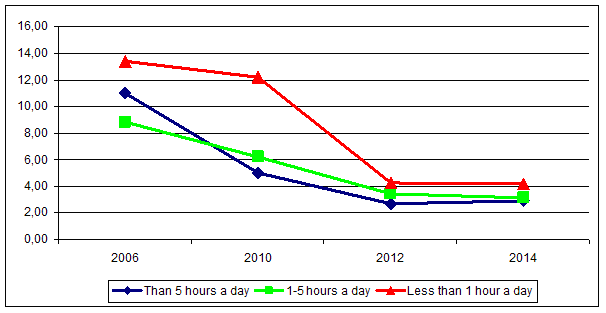Home
Issues
Aims and Scope
Open Access
Editorial Board
Indexing
Why publish with us
Contact us
Instructions to authors (PDF)
Manuscript Types
Manuscript Formatting
How to submit
Preprints
Special Publications & Reprints
Authorship & COI
Principles of Transparency Checklist
Data Policies
Publication Ethics and Publication Malpractice Statement
Exposure to second-hand smoke at work in the European Union, 2006 - 2014
1
ISPO, Italy
Publication date: 2018-03-01
Tob. Induc. Dis. 2018;16(Suppl 1):A148
KEYWORDS
TOPICS
ABSTRACT
Background:
After the classification of second-hand smoke (SHS) as a known human pulmonary carcinogen by International Agency for Research on Cancer (IARC), most Countries of the European Union (EU) introduced smoking ban at workplaces and public places.
Main aim of this study was to study trend of SHS exposure at work, 2006-2014.
Methods:
Figures were collected in four cross-sectional surveys representative of population of each EU Country. Surveys were conducted in 2006, 2010, 2012, 2014 (Eurobarometer 66.2, 72.3, 77.1, 82.4) in all 28 EU Countries.
The question on SHS exposure at work was recorded in bogh smokers and non-smokers: “How long are you exposed to tobacco smoke at your workplace?” Possible answers were: < 1 hour a day; 1-5 hours; >5 hours a day; Never or almost never; don't know, In the 2012 and 2014 surveys a new category was added: “occasionally exposed”.
Results:
Prevalence of exposure to SHS at work decreased by 69% from 2006 to 2014 (Figure 1).
The drop was recorded since 2010 for exposures for ≥1 hour per day, whereas the exposure to < 1 hour per day dropped in the 2012 survey.
In 2012 and 2014 17% of participants reported to be exposed occasionally, not on a daily basis. Occasional exposure at work was not recorded in previous surveys.
Figures of SHS exposure for each EU Country will be presented reporting also the year of implementation of smoking ban per each Country.

[Figure 1: SHS exposure ≥1 hour/day ]
Conclusions:
SHS exposure at work dropped in 28 EU Countries after the implementation of nationwide smoking bans.
After the classification of second-hand smoke (SHS) as a known human pulmonary carcinogen by International Agency for Research on Cancer (IARC), most Countries of the European Union (EU) introduced smoking ban at workplaces and public places.
Main aim of this study was to study trend of SHS exposure at work, 2006-2014.
Methods:
Figures were collected in four cross-sectional surveys representative of population of each EU Country. Surveys were conducted in 2006, 2010, 2012, 2014 (Eurobarometer 66.2, 72.3, 77.1, 82.4) in all 28 EU Countries.
The question on SHS exposure at work was recorded in bogh smokers and non-smokers: “How long are you exposed to tobacco smoke at your workplace?” Possible answers were: < 1 hour a day; 1-5 hours; >5 hours a day; Never or almost never; don't know, In the 2012 and 2014 surveys a new category was added: “occasionally exposed”.
Results:
Prevalence of exposure to SHS at work decreased by 69% from 2006 to 2014 (Figure 1).
The drop was recorded since 2010 for exposures for ≥1 hour per day, whereas the exposure to < 1 hour per day dropped in the 2012 survey.
In 2012 and 2014 17% of participants reported to be exposed occasionally, not on a daily basis. Occasional exposure at work was not recorded in previous surveys.
Figures of SHS exposure for each EU Country will be presented reporting also the year of implementation of smoking ban per each Country.

[Figure 1: SHS exposure ≥1 hour/day ]
Conclusions:
SHS exposure at work dropped in 28 EU Countries after the implementation of nationwide smoking bans.
CITATIONS (1):
1.
COMPARATIVE RISK-ORIENTED INTEGRATED ASSESSMENT OF LUNG HEALTH STATUS IN PREVENTIVE PLANNING OF REHABILITATION TREATMENT PROGRAMS IN A SANATORIUM
Mokin E.D., Mokina N.A.
Bulletin "Biomedicine and sociology"
Mokin E.D., Mokina N.A.
Bulletin "Biomedicine and sociology"
Share
RELATED ARTICLE
We process personal data collected when visiting the website. The function of obtaining information about users and their behavior is carried out by voluntarily entered information in forms and saving cookies in end devices. Data, including cookies, are used to provide services, improve the user experience and to analyze the traffic in accordance with the Privacy policy. Data are also collected and processed by Google Analytics tool (more).
You can change cookies settings in your browser. Restricted use of cookies in the browser configuration may affect some functionalities of the website.
You can change cookies settings in your browser. Restricted use of cookies in the browser configuration may affect some functionalities of the website.

